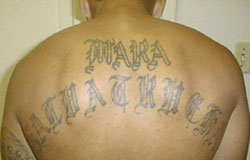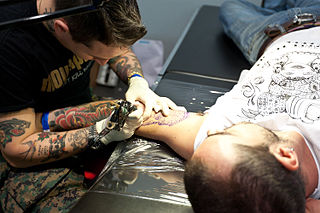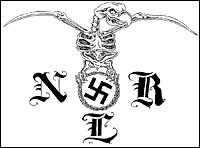
A tattoo is a form of body modification made by inserting tattoo ink, dyes, and/or pigments, either indelible or temporary, into the dermis layer of the skin to form a design. Tattoo artists create these designs using several tattooing processes and techniques, including hand-tapped traditional tattoos and modern tattoo machines. The history of tattooing goes back to Neolithic times, practiced across the globe by many cultures, and the symbolism and impact of tattoos varies in different places and cultures.

The Aryan Brotherhood is a neo-Nazi prison gang and an organized crime syndicate that is based in the United States and has an estimated 15,000–20,000 members both inside and outside prisons. The Southern Poverty Law Center (SPLC) has characterized it as "the nation's oldest major white supremacist prison gang and a national crime syndicate" while the Anti-Defamation League calls it the "oldest and most notorious racist prison gang in the United States". According to the Federal Bureau of Investigation (FBI), the Aryan Brotherhood makes up an extremely low percentage of the entire US prison population, but it is responsible for a disproportionately large number of prison murders.
Irezumi is the Japanese word for tattoo, and is used in English to refer to a distinctive style of Japanese tattooing, though it is also used as a blanket term to describe a number of tattoo styles originating in Japan, including tattooing traditions from both the Ainu people and the Ryukyuan Kingdom.

Criminal tattoos are a type of tattoos associated with criminals to show gang membership and record the wearer's personal history—such as their skills, specialties, accomplishments, incarceration, world view and/or means of personal expression. Tattoos have been empirically associated with deviance, personality disorders, and criminality.
A prison gang is an inmate organization that operates within a prison system. It has a corporate entity and exists into perpetuity. Its membership is restrictive, mutually exclusive, and often requires a lifetime commitment. Prison officials and others in law enforcement use the euphemism "security threat group". The purpose of this name is to remove any recognition or publicity that the term "gang" would connote when referring to people who have an interest in undermining the system.
A "thief in law" in the Soviet Union, the post-Soviet states, and their respective diasporas is a formal and special status of "criminal authority", a professional criminal who follows certain criminal traditions and enjoys an elite position among other members within organized crime and correctional facility environments and who has informal authority over lower-status members.

A gang sign, also known as a gang signal, is a verbal or visual way gang members identify their affiliation. This can take many forms including slogans, hand signs, colored clothing and graffiti. The wearer usually favors, or is in, that particular gang. Many of these, especially slogans and hand signs, have become part of popular culture, especially in African American hip hop culture.

The five dots tattoo is a tattoo of five dots arranged in a quincunx, usually on the outer surface of the hand, between the thumb and the index finger. The tattoo has different meanings in different cultures—it has been variously interpreted as a fertility symbol, a reminder of sayings on how to treat women or police, a way members of People Nation or Nuestra Familia affiliated gangs identify, a recognition symbol among the Romani people, a group of close friends, standing alone in the world, or time spent in prison. Thomas Edison had this pattern tattooed on his forearm.

The teardrop tattoo or tear tattoo is a symbolic tattoo of a tear that is placed underneath the eye. The teardrop is one of the most widely recognised prison tattoos and has various meanings.

A spider angioma or spider naevus, also nevus araneus, is a type of telangiectasis found slightly beneath the skin's surface, often containing a central red spot and deep reddish extensions which radiate outwards like a spider's web or a spider's legs. They are common and often benign, presenting in around 10–15% of healthy adults and young children. However, having more than three spider angiomas is likely to be abnormal and may be a sign of liver disease and/or hepatitis C ; it also suggests the probability of esophageal varices.

A tattoo artist is an individual who applies permanent decorative tattoos, often in an established business called a "tattoo shop", "tattoo studio" or "tattoo parlour". Tattoo artists usually learn their craft via an apprenticeship under a trained and experienced mentor.

Tattooing has been practiced across the globe since at least Neolithic times, as evidenced by mummified preserved skin, ancient art and the archaeological record. Both ancient art and archaeological finds of possible tattoo tools suggest tattooing was practiced by the Upper Paleolithic period in Europe. However, direct evidence for tattooing on mummified human skin extends only to the 4th millennium BC. The oldest discovery of tattooed human skin to date is found on the body of Ötzi the Iceman, dating to between 3370 and 3100 BC. Other tattooed mummies have been recovered from at least 49 archaeological sites, including locations in Greenland, Alaska, Siberia, Mongolia, western China, Egypt, Sudan, the Philippines and the Andes. These include Amunet, Priestess of the Goddess Hathor from ancient Egypt, multiple mummies from Siberia including the Pazyryk culture of Russia and from several cultures throughout Pre-Columbian South America.

The Nazi Lowriders, also known as NLR or the Ride, are a neo-Nazi, white supremacist organized crime syndicate, and prison and street gang in the United States. Primarily based in Southern California, the gang is allied with the larger Aryan Brotherhood and Mexican Mafia gangs, and fellow peckerwood gang Public Enemy No. 1. The Nazi Lowriders operate both in and outside of prison.
A variety of health effects can result from tattooing. Because it requires breaking the skin barrier, tattooing carries inherent health risks, including infection and allergic reactions. Modern tattooists reduce such risks by following universal precautions, working with single-use disposable needles, and sterilising equipment after each use. Many jurisdictions require tattooists to undergo periodic bloodborne pathogen training, such as is provided through the Red Cross and the U.S. Occupational Safety and Health Administration.

211 Crew is a white supremacist prison gang, active both in and out of prison, that was formed in 1995 at Colorado's Denver County Jail. It was linked to several high-profile murders and criminal investigations. Those included the assassination of Colorado Department of Corrections head Tom Clements. Due to a threatening letter sent by a Texas Aryan Brotherhood member, it was suspected to be linked to similar assassinations of Texas district attorney Mike McLelland, and his assistant prosecutor Mark Hasse, but a former Justice of the Peace was eventually indicted for those murders.

The process or technique of tattooing, creating a tattoo, involves the insertion of pigment into the skin's dermis. Traditionally, tattooing often involved rubbing pigment into cuts. Modern tattooing almost always requires the use of a tattoo machine and often procedures and accessories to reduce the risk to human health.

During the 20th century in the Soviet Union, Russian criminal and prison communities maintained a culture of using tattoos to indicate members' criminal career and ranking. Specifically among those imprisoned under the Gulag system of the Soviet era, the tattoos served to differentiate a criminal leader or thief in law from a political prisoner.

A face tattoo or facial tattoo is a tattoo located on the bearer's face or head. It is part of the traditional tattoos of many ethnic groups.

The Soldiers of Aryan Culture (SAC), sometimes referred to as Soldiers of the Aryan Culture and Soldiers of an Aryan Culture, is a large American white supremacist prison gang.
The Universal Aryan Brotherhood (UAB), also known as the Universal Family, are an active neo-Nazi white supremacist prison gang in the United States. Primarily based out of Oklahoma, the gang also has members in federal custody, as well as in several states across the country.















